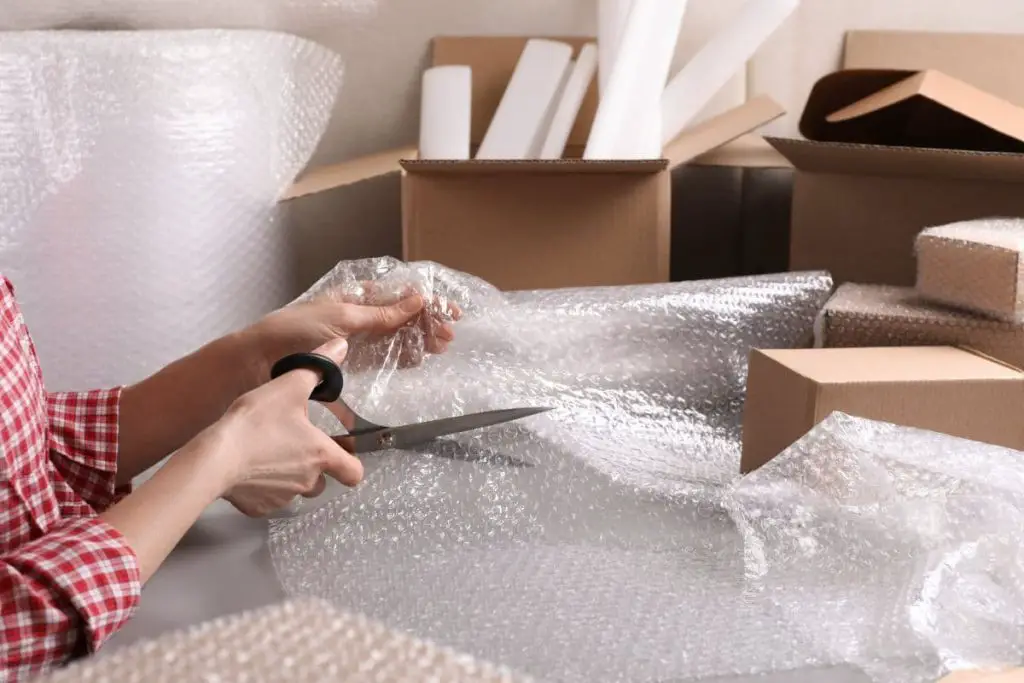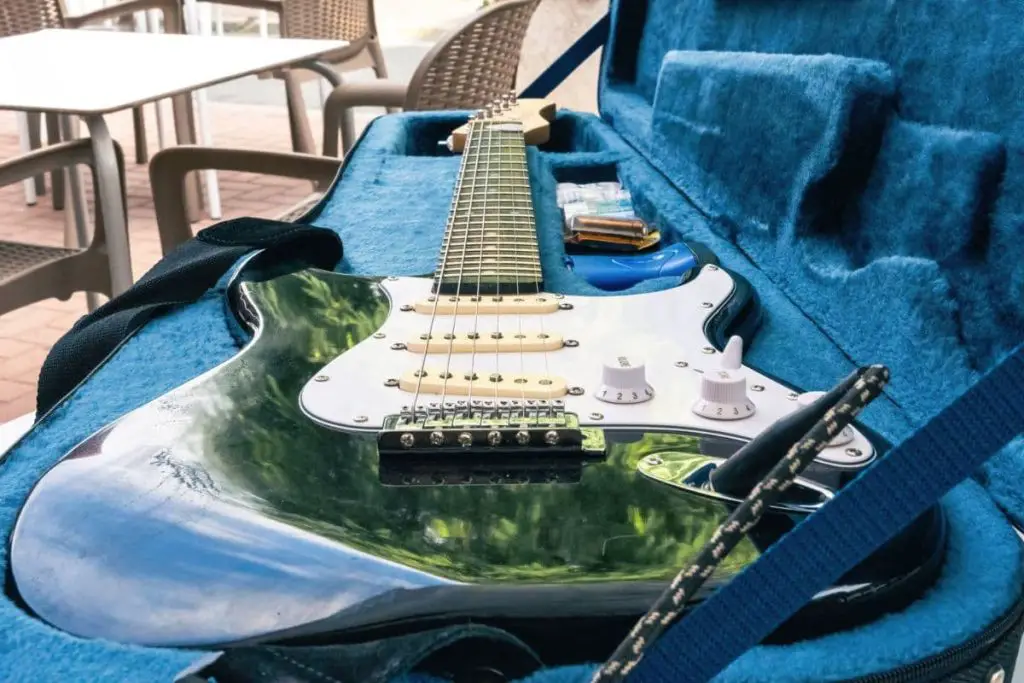Shipping a guitar isn’t the best choice, but in some cases, it’s the most efficient option, especially if you’re moving or traveling far from home. However, some might wonder whether you can ship your electric guitar with and without a case. The good news is that you can do both as long as you follow a few steps.
You can ship your guitar by removing the strings, securing loose pieces, and padding the instrument in a secure box or a hardshell case. Better packaging reduces damage from poor handling. Packing the instrument in a gig bag or two boxes can also provide some extra protection.
This article will outline the mandatory steps to packing and shipping your electric guitar, with and without a case, to avoid worst-case scenarios. I’ll also suggest various inexpensive materials to use in the filling process, including ones you can find lying around the house!
How to Ship a Guitar Safely
Shipping a guitar can be a stressful and nerve-wracking process, but with proper packing and handling, it can arrive at its destination safely.
Here are some steps to follow to ensure your guitar is packaged and shipped securely:
- Loosen the Strings: Loosen the guitar strings to relieve tension on the neck and help prevent damage during transport.
- Protect the Headstock: The headstock is the most fragile part of a guitar and should be protected with bubble wrap or foam. Make sure the wrap is thick enough to provide adequate cushioning, and secure it in place with tape.
- Wrap the Body: Wrap the guitar body with bubble wrap or foam, ensuring that all parts of the guitar are covered. Tape the wrap securely in place to prevent it from shifting during transport.
- Place the Guitar in a Case: Place the wrapped guitar in a hardshell case and secure it in place with packing materials such as foam or bubble wrap. Make sure the guitar is snugly fit in the case, with no space for it to move around.
- Seal the Case: Seal the case with strong packing tape and label it “Fragile” to ensure it is handled with care during shipping.
- Place the Case in a Box: Place the guitar case in a sturdy shipping box with at least 2 inches of cushioning on all sides. Use packing peanuts, bubble wrap, or foam to fill any empty space in the box.
- Seal the Box: Seal the box with strong packing tape and label it “Fragile” and “Handle with Care” on all sides of the box.
- Choose a Reliable Shipping Carrier: Choose a reputable shipping carrier with a track record of safely transporting fragile items. Insure the guitar for its full value and request signature confirmation on delivery.
- Double Check the Package: Double-check the package to make sure it is securely sealed and labeled with the correct address and return address.
If you want to find out what my recommended guitar gear is, then here is what I recommend on Amazon:
- Fender Cutaway Acoustic-Electric Guitar Bundle (MY FAVORITE GUITAR)
- Snark SN-8 Super Tight All Instrument Tuner (Easiest Tuner I’ve Used)
- 6 String Acoustic Guitar Capo (Best CAPO for quick changes)
- Dunlop Max Grip 1.0mm Nylon Picks (Thick Guitar Pick So You Don’t Lose Grip!)
- Universal Guitar Stand (Cheap & Minimalist Guitar Stand I Recommend)
- Levy’s 2″ Wide Quick Adjust Guitar Strap (Best Guitar Strap For Any Level)

How To Ship a Guitar Without a Case
Shipping your guitar without a case is doable but should be a last resort. Hardshell cases add durability to the package, especially so it can withstand the bumps and bangs accompanied by transportation.
However, in situations where that isn’t possible, the steps below outline just what to do to keep your instrument safe for shipment when it doesn’t have a case.
1. Get a Box and Packing Materials
Since your guitar won’t have an added layer of protection by way of a case, you’ll need to gather lots of packing materials to ship your instrument, including:
- A large box, big enough to hold your instrument (but not so big that the instrument will shift or move around during transport– especially when it is packed with filler)
- Packing paper, bubble wrap, foam sheets
- Furniture moving pads (you should purchase three or four, at least)
- Box tape
- A gig or padded bag
Most hardware and shipping services have these items in stock. However, you can also purchase complete guitar packing kits at your closest UHaul or USPS location.
2. Prepare Your Guitar
To prepare your guitar for packing, remember that the ultimate goal is to secure your instrument in place and prevent as much movement as possible. Since it will be packed tightly, remove or loosen the strings on the guitar, as well as any other part of the instrument that sticks out or could be knocked off.
This includes loosening knobs (tuning or volume dials) and removing any other protruding components like the whammy bar or clip-on tuners.
If you’re removing things from your guitar, you can pack them in a separate, smaller box and secure them with tape. That box can sit inside the shipment box safely.
Finally, use a few sheets of packing paper to slip beneath and over top of your strings (if you’ve left them on) to prevent them from rubbing against the fretboard. You should also wrap the headstock with a few layers of bubble wrap and secure it with tape. You can also use craft paper or corrugated wrap to shield the headstock. Once this is done, you’re ready to move on to step three.
Eco Kraft Wrapping Paper Roll Wrapping Paper (available on Amazon.com) is an excellent, eco-friendly paper to protect your strings, fretboard, and guitar body.
3. Wrap the Guitar
Next, it’s time to lay out the furniture pads to wrap your guitar in them. One furniture pad should be enough to cover the guitar altogether. Lay the guitar in the center of the pad, and fold the sides over until the entire guitar is gone.

Once it’s secured, you’ll want to add extra protection by wrapping the padded guitar with bubble wrap. The guitar should be cushioned on every side, including the top and bottom, and then secured with tape.
If you want to double-box your instrument or put it in a gig or other padded bag, you’ll need to do that before wrapping it in bubble wrap. If you do decide to do this, make sure to fill the second box or bag with packing paper to keep it as immobile as possible, just as you’ll do in step four.
When you’re done, your guitar should be swaddled like a newborn baby with furniture pads and bubble wrap, and the packaging should be at least a few inches thick. You can buy uBoxes Large Bubble Roll (available on Amazon.com) in packs of two to accomplish this.
4. Package Your Guitar and Fill the Space
Once your guitar is wrapped up and ready to go, you can carefully slide it into the shipping box bottom-first. Furniture pads or a moving blanket should line the inside walls of the box, including the bottom, and any excess space in the box must be filled.
You can fold furniture pads or roll up moving blankets, like the US Cargo Control Moving Blanket (available on Amazon.com), to wedge in between the guitar and the box’s walls. These moving blankets are durable, thick, and easy to manipulate, so using them as a filler adds some extra protection.
Suppose you don’t have either of these. In that case, you can use crumpled-up packing paper, foam pads, shredded cardboard, or any other material to cushion the instrument and the box’s walls.
Use packing tape to close the box and secure it shut. Be generous with the packing tape. It’s better to need more tape than to have some extra tape and a damaged guitar.
Once you’re done with all of these steps, your guitar should be ready for safe shipment, even without a case.
You can read on to learn how to ship your guitar in its case, with suggestions for alternative packing materials to use on a budget!
How To Ship a Guitar With a Case
Since guitars are so fragile (and cost so much of our hard-earned money), the best recommendation for safe shipping is to send them off in a case. The steps to shipping with a case are only slightly different; the shipping box will need to be bigger to accommodate the case size (20 x 8 x 50 inches [50.8 x 20.3 x 127 centimeters] is recommended).

After gathering the box and other materials, you’re ready to prepare your guitar for packing.
1. Prep Your Guitar for Packaging
String removal and knob loosening are in order, just as before. It’s important to mention that you don’t need to remove the strings like you would without a case. Guitar cases are built specifically for guitars, so string damage is an unlikely possibility.
However, erring on the side of caution can be smart so consider at least loosening them to prevent possible snapping or rubbing.
Here are a few more tips on prepping your guitar:
- Whammy bars and tuners should be removed from the instrument and placed in a smaller box for travel. Again, this box can stay inside the main package, or you can slip them into one of the case’s inner pockets. (Be sure to store them in a Ziplock if you go this route).
- Cover the loosened strings with folded packing paper if you haven’t removed them, and make sure to add paper between the strings and the fretboard, too. You can even cover the guitar’s body with paper if you are worried about scratching the instrument, but the most important pieces to protect are the strings, the frets, and the pickups.
- Finally, make sure to secure the headstock with bubble wrap and tape. This will protect all of the tuning knobs. A good buy for covering the headstock is the Uboxes Bubble Out Bag (available on Amazon.com), a cushioned bubble wrap bag that you can slide over and secure in place with tape.
If bubble wrap isn’t available, you can slip a few layers of thick socks on– to the guitar, of course– and tape the opening tightly. Make sure not to apply the tape onto the instrument as this could ruin the neck and strings.
2. Secure the Guitar in Its Case
This is where things get a little bit different. When your guitar is ready, you must first secure it in its case and use packing paper, Nanuk Foam Inserts (available on Amazon.com), or other material to fill the empty spaces inside the case. You want the inside of the case to be just as snug as the case will be in its shipment box.
Another option to fill the space in your case is to use Mighty Gadget Thick Foam Sheets (available on Amazon.com), which are softer and have more cushion than packing paper does. You can purchase a pack of 100, which is more than enough for one shipment. Make sure to pack up the space underneath your instrument’s neck and the edges between the case and body.
A gig bag or a padded case would do fine if you don’t have a hardshell case. All of the same steps apply regardless of the case it’s in. After this step, your guitar should be tightly packed into its case. Close and lock the lid, and you’re ready for step three.
3. Wrap the Case
Instead of wrapping the individual instrument, this time, you need to cover the entire case in a furniture pad or a moving blanket and bubble wrap. However, double-boxing your guitar isn’t mandatory since it’s got a case.
If you do go this route though, stand the case upright and layer the whole thing once or twice with bubble wrap. Don’t forget to wrap the tops and bottoms of the case as well. Once it’s fully covered, secure it with tape and prepare to load it into the shipping box.
If desired, you can first wrap the case in a blanket or pad before the bubble wrap. Even a thin bed comforter would do in a pinch. The more protection, the safer the guitar, after all!
With that being said, though, this step isn’t completely necessary if you have a case, so that extra layer of protection is really more of a personal preference.
4. Pack It Up and Fill the Space
Finally, pack the case into the shipment box and fill the empty space with a furniture pad or a more accessible material if you don’t have a furniture pad. Although incredibly sticky and unpredictable, foam peanuts are a great alternative to furniture pads or other foam fillings.
Everything should be as snug as a bug in a rug by the time you’re finished, which is why the pads are so convenient.
To test out your packing, give the box a shake and try to move it around in its packaging. If you hear it shifting, you’ll need to add more packing materials to the inside of the shipment box.
Here are some alternatives to bubble wrap that you can use to fill any of the box’s excess space, including items that you may be able to find around the house:
- Air pillows
- Corrugated bubble wrap
- Kraft paper, crumpled up
- Shredded cardboard
- Foam peanuts
- Guitar neck cutout (this isn’t a filler, but instead a cardboard cutout that slips over the neck of the guitar before it’s placed in the case, which prevents excessive shifting)
- Socks rolled up pillowcases or bedsheets
- Crumpled up newspaper
Secure the Box and Send It Off
Packing your guitar with and without a case is as simple as that! After the shake test, you can secure your shipment box up with packing tape, and it’s ready to go.

Don’t send it off without telling it you love it, though, and that you’ll be reunited soon.
Tips To Consider When Shipping a Guitar
There are a couple of other things you can do to ensure your guitar is shipped safely that have nothing to do with how you pack it.
To start, ship your package with one of the insured shipping services– USPS offers priority and standard shipping insurance, as do most postal services like FedEx, UPS, and Canada Post. If your package gets damaged, you’ll have a certain amount of coverage through shipping insurance.
Second, use Anylabel Fragile/Handle With Care Stickers (available on Amazon.com) on the package to let handlers know that its contents are delicate. You can also purchase these stickers at your local Walmart or office supply store. If you put one sticker on each side of the package, it’ll be a lot easier to spot.
Finally, write down the company’s contact information and your package tracking number. That way, if there are any problems, you’ll be able to contact customer service with the appropriate information to sort out any issues.
How To Ship A Guitar Internationally
Shipping a guitar internationally can be a bit more complicated than shipping it domestically due to customs requirements and regulations. Here are some general steps to follow when shipping a guitar internationally:
- Check customs requirements: Before shipping a guitar internationally, make sure to check the customs requirements and regulations of the destination country. Some countries may have restrictions on the import of certain woods or materials.
- Choose a carrier: Select a reliable carrier that has experience with international shipments. Some popular carriers for international shipping include FedEx, UPS, and DHL.
- Pack the guitar: Wrap the guitar in bubble wrap, and place it in a sturdy cardboard box. Use packing peanuts or other materials to fill any empty spaces in the box to prevent the guitar from moving around during transit.
- Declare the value: When shipping internationally, you will need to declare the value of the guitar for customs purposes. This will determine the amount of taxes and duties that will be assessed.
- Fill out customs forms: You will need to complete customs forms that provide information about the contents of the package and its value. Be sure to provide accurate and detailed information.
- Pay for shipping: International shipping can be expensive, so be prepared to pay a higher fee than you would for domestic shipping.
- Track the shipment: Once the guitar has been shipped, track its progress to ensure that it arrives at its destination.
Why Is It Important To Pack a Guitar Properly For Shipping?
There is a common assumption that shipping and handling services sometimes mishandle our packages.
True or not, accidents do happen all the time, including packages being dropped, knocked around in delivery vehicles, squashed beneath other heavy boxes, and so much more. That seemingly overkill padding protects the guitar from any and all external impact.
If the box was knocked hard enough on the neck, for example, and there wasn’t any padding in the case beneath it, you might find yourself with a dented guitar neck on the other side of shipping.
Too rough of a toss could also ding up the body if it didn’t have a filler between it and the case’s edges. While it’s nice to have insurance for these scenarios, taking preventative action is always the best thing to do.
It’s even more concerning when the instrument isn’t placed in a case and can sustain damage easier through the cardboard shipping box. The furniture pads and moving blankets are large and girthy; one or two of them will suffice to fill the box and cushion any potential blows from shipping.
It’s also worth mentioning that if you’re flying with your guitar, you can bring it onto the plane as a carry-on instead of checking it as luggage.
Baggage carriers are also notorious for mishandling (and even losing) luggage, so pack your guitar up in its case or bag and bring it straight onto the flight with you for safekeeping.
Similarly, you can bring your instrument onto a train to avoid possible damage from a luggage pile-up.
On the other hand, buses don’t have the space to accommodate a large instrument, so, in any situation where you need to pack your guitar away and let others handle it, following the above steps will help ensure your guitar is returned to you exactly how you left it.

Final Thoughts on How To Ship A Guitar
You can ship your electric guitar, whether it is in a case or not. The only requirement is significant packing– inside the case if your guitar has one and inside the shipping box if it doesn’t. Air cushions, packing peanuts, corrugated bubble wrap, and shredded cardboard are all excellent materials to fill the packaging with, but any material will do.
As long as your guitar is immobile in its box and surrounded by some form of cushion, it should arrive at its destination safely, and you’ll be able to play it once again!
How To Ship A Guitar FAQ
Here are some common questions.
How much does it cost to ship a guitar?
The cost of shipping a guitar depends on several factors, including the destination, shipping method, and the weight and dimensions of the package. Generally, the cost of shipping a guitar within the United States using a reputable carrier such as UPS or FedEx ranges from $50 to $150, with additional costs for insurance and special handling.
International shipping costs can be significantly higher and can vary widely depending on the destination country and the shipping carrier. It’s best to check with the carrier directly or use their online shipping calculators to get an accurate estimate of the cost. Additionally, it’s important to properly package and protect the guitar to prevent damage during shipping, which may add to the overall cost.
How much does USPS charge to ship a guitar?
The cost of shipping a guitar through USPS varies depending on the weight, dimensions, and shipping speed. The cost to ship a guitar domestically within the US through USPS ranges from around $20 for standard ground shipping to over $100 for express or overnight shipping. Additional insurance or signature confirmation may also increase the cost. It’s best to check with USPS for the most accurate pricing based on the specific details of the shipment.
Can I ship a guitar via USPS?
Yes, you can ship a guitar via USPS (United States Postal Service). However, you will need to follow certain guidelines and packaging requirements to ensure that your guitar is shipped safely and arrives at its destination in good condition. USPS offers several different shipping options, including Priority Mail and Priority Mail Express, which may be suitable for shipping a guitar depending on the size and weight of the package.
Will UPS pack a guitar for shipping?
Yes, UPS offers packing services for shipping guitars. They offer a variety of packaging options, including custom boxes and foam inserts designed specifically for shipping guitars. Additionally, they offer insurance options to help protect your instrument during shipping.
Will FedEx package a guitar?
Yes, FedEx offers packaging services for guitars and other musical instruments. They have specially designed boxes for guitars that provide ample protection during shipping. In addition, they offer different levels of shipping services, including ground, express, and overnight options, to meet the needs of different customers. It is always recommended to consult with FedEx or any shipping provider to ensure the proper packaging and labeling of the guitar to ensure a safe delivery.
Is it a good idea to ship a guitar?
Shipping a guitar can be a good idea if done correctly. It allows you to easily transport your guitar to a destination that you otherwise couldn’t bring it to. However, shipping a guitar can also come with risks such as damage or loss during transit. To mitigate these risks, it’s important to properly pack and insure your guitar before shipping it. It’s also important to choose a reputable shipping carrier with experience in handling musical instruments.
What is the best way to mail a guitar?
The best way to mail a guitar depends on several factors such as the type of guitar, the shipping distance, and the available shipping services in your area. However, there are some general tips that can help you to mail a guitar safely:
- Detach the guitar’s neck: If possible, detach the guitar’s neck from the body to reduce the risk of damage during transit.
- Use a hardshell case: Use a hardshell case to protect the guitar during transit. Make sure the guitar fits snugly in the case and is not moving around.
- Use proper packing materials: Use packing materials such as bubble wrap or foam to cushion the guitar inside the hardshell case.
- Choose a reputable shipping carrier: Choose a reputable shipping carrier that has experience in shipping fragile items such as musical instruments. FedEx, UPS, and USPS all offer guitar shipping services, so you can choose the one that is most convenient for you.
- Insure the package: Insure the package to protect against damage or loss during shipping. This will give you peace of mind and provide compensation in case of any damage or loss.
- Label the package as fragile: Label the package as fragile to ensure that it is handled with care during transit.
Can you ship a guitar without a box?
It is not recommended to ship a guitar without a box as the guitar will not be adequately protected from damage during transit. A box provides a sturdy and protective layer around the guitar, helping to prevent scratches, dents, and other types of damage that can occur during shipping. Additionally, a box provides a barrier against moisture and other environmental factors that can harm the guitar during shipping. It’s important to properly package a guitar in a box with appropriate packing materials to ensure its safe arrival.
How to ship a guitar for cheap?
Here are some ways to ship a guitar for cheap:
- Choose the right shipping carrier: Some carriers offer discounted rates for large and/or heavy items. Compare prices from different carriers such as USPS, UPS, and FedEx to find the best deal.
- Use a gig bag instead of a hard case: Gig bags are lighter and more compact than hard cases, so they may be a more affordable option for shipping a guitar. However, keep in mind that they offer less protection.
- Disassemble the guitar: If possible, remove the neck and pack it separately to reduce the size and weight of the package.
- Use cheaper packing materials: Bubble wrap and foam are effective but can be expensive. Consider using blankets, towels, or other soft materials to wrap the guitar.
- Ship during off-peak periods: Shipping during busy periods like holidays and weekends can be more expensive. Try to ship during weekdays and non-peak periods to save money.
Note that while these methods may help to reduce the cost of shipping, it’s important to ensure that the guitar is properly protected and packaged to prevent damage during transit.
What is the best company to ship a guitar with?
The best company to ship a guitar with depends on various factors such as the destination, shipping speed, and the level of insurance required. Some of the most popular shipping companies for musical instruments are UPS, FedEx, and USPS. All of these companies have options for shipping guitars, with varying prices and shipping speeds. Other companies that specialize in shipping musical instruments include The Guitar Hanger, Roadie, and Shipnex. It’s important to research each company’s shipping policies and prices before choosing the best option for your needs.
How do you wrap a guitar for shipping?
Here are the steps to wrap a guitar for shipping:
- Loosen the strings: Before packaging the guitar, loosen the strings to relieve tension on the neck and to prevent any damage to the guitar.
- Protect the tuning pegs: Wrap a few layers of bubble wrap around the tuning pegs to prevent them from scratching the guitar’s body.
- Wrap the guitar in bubble wrap: Wrap the guitar body, neck, and headstock in several layers of bubble wrap. Secure the bubble wrap with packing tape.
- Protect the guitar case: If you are shipping the guitar in a case, make sure the case is also wrapped in bubble wrap.
- Secure the guitar in a box: Choose a sturdy guitar box that fits the guitar snugly. Fill any gaps with packing material such as bubble wrap or foam peanuts. Place the wrapped guitar in the box, making sure it is secure and cannot move around.
- Seal the box: Close the box and seal it with packing tape. Label the box with the recipient’s address and your return address.
- Choose a shipping carrier: Choose a shipping carrier such as FedEx, UPS, or USPS, and ship the guitar according to their guidelines for fragile items.
If you want to find out what my recommended guitar gear is, then here is what I recommend on Amazon:
- Fender Cutaway Acoustic-Electric Guitar Bundle (MY FAVORITE GUITAR)
- Snark SN-8 Super Tight All Instrument Tuner (Easiest Tuner I’ve Used)
- 6 String Acoustic Guitar Capo (Best CAPO for quick changes)
- Dunlop Max Grip 1.0mm Nylon Picks (Thick Guitar Pick So You Don’t Lose Grip!)
- Universal Guitar Stand (Cheap & Minimalist Guitar Stand I Recommend)
- Levy’s 2″ Wide Quick Adjust Guitar Strap (Best Guitar Strap For Any Level)
Related Posts:

